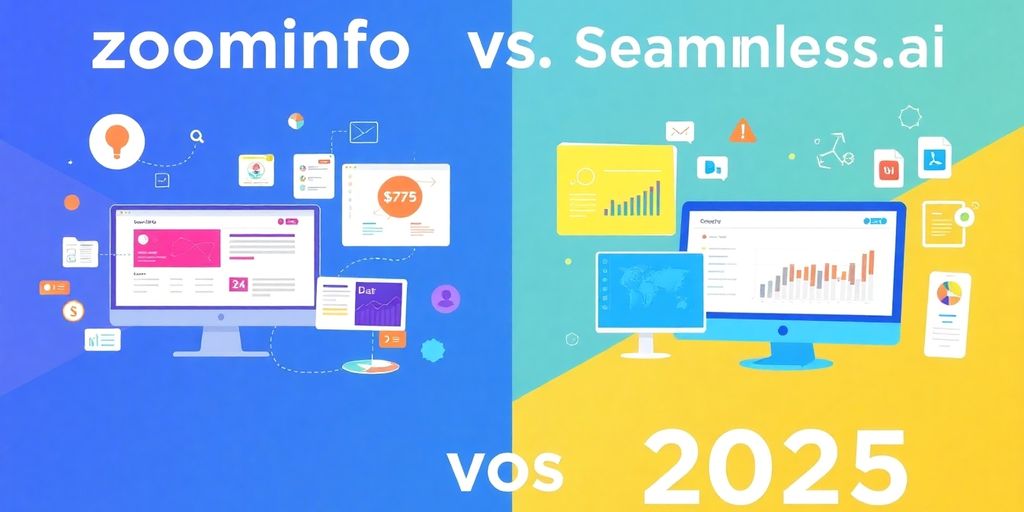Last updated on May 26th, 2025 at 07:00 am
In today’s fast-paced educational landscape, students are increasingly turning to artificial intelligence tools to enhance their learning experience. From writing assistance to research support, these AI resources can help students manage their academic workload more effectively.
In this article, we’ll explore the best free AI tools for Teachers and Educators, highlighting their unique features and benefits. So, what are the top AI resources available for student use? Let’s find out!

Key Takeaways
- AI tools can significantly improve productivity and efficiency for students.
- These resources cater to various needs, from writing to research and learning support.
- Many AI tools are user-friendly and accessible, making them ideal for students of all levels.
- Using AI can help students grasp complex concepts at their own pace.
- Integrating AI into study routines can enhance engagement and motivation.
1) ChatGPT

Okay, so ChatGPT. Where do I even start? It’s everywhere, and for good reason. It’s like having a super-smart study buddy who never sleeps. I’ve been using it for everything from brainstorming essay ideas to figuring out why my code keeps crashing.
It’s not perfect, of course. Sometimes it hallucinates facts or gets a little too confident about things it’s not sure of. But overall, it’s a game-changer, especially now that the free version gives you access to GPT-4o. That’s the new model, and it’s seriously fast and smart.
I’ve found that ChatGPT is great for getting a quick overview of a topic or for rephrasing something I’ve written. It’s also surprisingly good at explaining complex concepts in a way that’s easy to understand. Just remember to double-check everything, especially if it’s for a big assignment.
Here’s a quick rundown of what I use it for:
- Brainstorming topics
- Summarizing long articles
- Debugging code
- Translating text
And the best part? The free version is pretty powerful. You can generate a ton of content without paying a dime. Of course, the paid version gives you even more features, like faster response times and access to even more advanced models. But for most students, the free version is more than enough to get started.
2) Grammarly
Okay, so Grammarly. I’m pretty sure everyone’s heard of it, right? It’s like the OG when it comes to online grammar checkers. I remember using it back in high school, and it’s still around, which says something. It’s not just about catching simple mistakes anymore; it’s gotten way more advanced.
Grammarly uses AI to give you real-time suggestions on your grammar, spelling, style, and even tone. It’s pretty cool because it figures out what you’re trying to say and helps you say it better. I’ve found it super useful for making sure my emails don’t sound like I wrote them in a rush (even when I did!).
I think the best part is how it integrates with pretty much everything. Gmail, Google Docs, Word—you name it. It’s always there, quietly doing its thing in the background.
Here’s a quick rundown of what Grammarly brings to the table:
- Real-time grammar and spelling checks: Catches errors as you type.
- Style suggestions: Helps improve clarity and readability.
- Tone detection: Ensures your writing sounds the way you intend.
- Plagiarism checker: Useful for students to avoid accidental plagiarism.
Grammarly is a solid choice if you want to polish your writing and avoid embarrassing mistakes. It’s like having a personal editor, but without the hefty price tag. There’s a free version that’s decent for basic stuff, but the premium version is where it really shines. It’s worth checking out if you’re serious about improving your writing skills. It’s great for grammar correction and editing.
3) Quillbot
Okay, so Quillbot. I remember when I first heard about it, I was skeptical. Another AI writing tool? But honestly, it’s pretty useful, especially when you’re staring at a blank page or just can’t seem to phrase something right. It’s great for paraphrasing, checking grammar, and even summarizing text.
It’s not perfect, of course. Sometimes the paraphrasing can be a little wonky, and you definitely need to double-check everything. But for getting past writer’s block or making sure your essay doesn’t sound like everyone else’s, it’s a solid option. Plus, they have a free version, which is always a win for students on a budget. It’s limited, sure, but enough to get a feel for what it can do. I’ve found it particularly helpful for rephrasing sentences when I’m trying to avoid plagiarism. It’s like having a second pair of eyes (or, well, an AI brain) to help you out. It’s not going to write your paper for you, but it can definitely make the process a whole lot easier. I’d recommend giving Quillbot’s paraphrasing tool a try if you’re struggling with your writing.
I’ve used Quillbot to help me rephrase sentences in my research papers. It’s not a magic bullet, but it definitely helps me get past writer’s block and make sure my writing is clear and concise.
Here’s a quick rundown of what you can do with Quillbot:
- Paraphrase text
- Check grammar
- Summarize articles
- Generate citations
4) Google Gemini
Google Gemini is making waves as a strong AI assistant, especially for students already plugged into the Google ecosystem. It’s designed to help with everything from research to creative projects, and its integration with Google Workspace apps makes it super convenient. Whether you’re drafting emails, summarizing articles, or just need quick answers, Gemini aims to deliver smoothly.
I’ve found it useful in some unexpected situations. For example, when I was struggling with a confusing sizing chart while shopping for clothes online, I snapped a picture of the label and let Gemini handle it. The suggestion was spot-on! For creative projects, Gemini’s image capabilities are pretty cool. I uploaded an image I liked and asked it to describe it as a prompt for an AI image generator. The results were creative and inspiring, making it a fun tool for brainstorming new ideas. It can summarize an entire web page from its URL!
Here’s a quick rundown of what Gemini can do:
- Research the latest data
- Generate concise content in easy-to-understand language
- Write code and get code explanations
- Brainstorm ideas
Gemini Advanced provided tailored suggestions that felt like a genuine productivity boost. It even made copywriting easier—generating meaningful text for design mockups that felt polished, rather than using generic filler like “Lorem Ipsum.”
While the free Basic version (using the 1.5 Flash model) covers most casual needs, the $19.99/month Gemini Advanced adds the more powerful 1.5 Pro and Gemini-Exp-1206 models for complex tasks like coding, math, and deep research, including analyzing texts up to 1,500 pages. It’s worth checking out if you need that extra power. Overall, if you need to enhance your research with the latest data, Google Gemini is a solid choice.
5) ChatPDF
Okay, so ChatPDF is pretty cool. Basically, it’s an AI tool that lets you chat with your PDFs. I know, sounds kinda weird, but hear me out. You upload a PDF – could be a textbook, a research paper, whatever – and then you can ask it questions about the document. It’s like having a super-smart study buddy that’s actually a computer program.
I think the best part is how quickly you can find information. Instead of spending hours flipping through pages, you just ask ChatPDF, and it gives you the answer. It’s especially useful for research when you’re trying to pull specific details from a bunch of different sources. It can really speed up the learning process for students and promote self-learning.
I’ve been using it to help me understand some dense academic papers, and it’s been a lifesaver. It’s like having a personal research assistant that never gets tired of answering my questions.
Here’s a quick rundown:
- Upload your PDF.
- Ask questions about the content.
- Get answers instantly.
- Save time on research and studying.
ChatPDF can analyze the PDF and answer questions using that information in the chat window. Students can quickly resolve their doubts, understand complex concepts, and fetch important information from any book through this tool. It’s a great way to engage with PDF documents and get the information you need quickly.
Also Read : 15+ Best AI Tools For Students In 2025 (FREE & Paid)
6) Natural Readers
Natural Readers is a pretty popular text-to-speech platform, and it’s easy to see why. You can upload documents, web pages, or even images, and it’ll read them aloud. It’s used by over 10 million people. Just pick an AI voice and speed, and you’re good to go. It’s super handy for anyone who wants to listen to content instead of reading it.
I’ve found it especially useful when I’m trying to review notes while doing chores around the house. It’s a great way to multitask and still get some studying done. Plus, it’s a lifesaver when my eyes are tired from staring at a screen all day.
It even has a Chrome extension, so you can listen to emails, ebooks, blogs, Google Docs, and PDFs on the go. It’s also helpful for students with learning disabilities. The free plan lets you convert 4k characters per day. However, one user expressed dissatisfaction with Natural Readers, stating that the service fails to read a significant portion of the content.
Here’s a quick rundown of what you can do with Natural Readers:
- Listen to documents on the go
- Convert text from images to speech
- Use it with a Chrome extension
It’s a great tool for anyone who wants to listen to text instead of reading it.
7) Mubert
Mubert is an interesting one. It’s all about AI-generated music. If you’re working on a project and need some background tunes, or maybe you’re trying to create a soundtrack for a video, Mubert could be your go-to. It’s not just about pre-made tracks; you can actually influence the kind of music it generates. Think of it as having a personal AI composer at your fingertips.
- Custom Music Creation: Tailor music to fit specific needs.
- Royalty-Free: Use the generated music without copyright worries.
- Mood and Genre Options: Experiment with different styles to match the project’s tone.
I remember when I first tried Mubert. I was working on a short film and needed something atmospheric but couldn’t find the right track anywhere. Mubert let me tweak the parameters until I got something that fit perfectly. It saved me a ton of time and money.
8) Doctrina AI
Doctrina AI is like having a super-smart study buddy, but without the awkward small talk. It’s an AI teaching assistant, and it was specifically developed by Indiana University. So, it’s designed to understand what students need, which is pretty cool.
Think of it this way:
- Need help understanding a tricky concept? Doctrina AI can break it down.
- Stuck on a problem set? It can offer guidance without just giving you the answer.
- Feeling overwhelmed by the amount of material? It can help you prioritize.
It’s not meant to replace your professors or TAs, but it’s there to give you that extra boost when you need it. It’s like having a personalized tutor available 24/7, which can be a lifesaver during those late-night study sessions. It’s all about making learning more accessible and less intimidating.
It’s worth checking out if your school offers it. It could seriously change how you approach your studies. Plus, it’s always good to generate high-quality exams to test your knowledge.
9) Tutor AI
So, you’re struggling with a tough subject? Well, Tutor AI might just be your new best friend. It’s basically an AI-powered tutoring platform designed to connect students with qualified tutors. Think of it as having a study buddy available whenever you need help with those tricky assignments or subjects.
Tutor AI can offer valuable guidance and support, helping you get a better grasp on different topics. It’s like having a personalized mentor that understands your learning style and pace.
AI in education is becoming more common, and Tutor AI is a great example of how it can be used to help students. It’s not just about getting answers; it’s about understanding the material and improving your overall academic performance. The adaptive nature of AI algorithms allows students to receive tailored instruction, ensuring that they fully understand the material before moving on. This personalized approach has been shown to significantly improve academic performance and retention rates.
I remember when I was struggling with calculus, and something like this would have been a lifesaver. Instead, I spent hours watching confusing YouTube videos and stressing out. Having a tutor available 24/7 would have made a huge difference.
Here’s what you can expect from Tutor AI:
- Schedule virtual tutoring sessions.
- Receive personalized assistance.
- Get help with difficult subjects or assignments.
It’s all about making learning more accessible and effective. Plus, with AI adapting to your learning style, it can make the whole process a lot less painful. If you’re looking for a way to boost your grades and actually understand what you’re learning, Tutor AI is worth checking out. It’s one of the many AI tools for students that are changing the game in education.
10) AskCodi
Coding can be tough, and sometimes you just need a little help without bugging your teachers constantly. That’s where AskCodi comes in. AskCodi is like having an AI-powered coding assistant right at your fingertips, designed to make programming and development easier. It’s pretty useful if you’re just starting out and need a hand understanding the basics.
AskCodi supports over 55 languages, which is great if you’re experimenting with different coding styles. You can also translate code into different languages and get explanations, which is super helpful for learning. One of the cool things is that you can pick your preferred language model, like GPT 3.5, GPT 4o mini, or Claude 3 Haiku. This lets you tailor the AI’s responses to your specific needs.
AskCodi can help with coding, testing, and even documentation. It’s a solid tool for anyone looking to improve their coding skills, especially if you’re just getting started.
With the free plan, you get 50 monthly credits, which should be enough for most students. Here’s a quick look at what you get:
- Code generation
- Code translation
- Code explanation
If you’re looking for a tool to help you with coding, check out AskCodi.
11) Hocoos
Okay, so you need a website, like, yesterday? Hocoos is an AI website builder that might just be your new best friend. It’s designed to get you up and running with a basic site super fast, which is pretty sweet when you’re juggling classes, assignments, and trying to have some semblance of a social life.
Basically, it asks you a bunch of questions about what you want your site to do – is it for a blog? A college project? What’s its purpose? What makes it special? – and then it spits out a few different website styles for you to pick from. You can tweak the fonts, colors, and even use its AI writer to mess with the content. It’s not going to win any design awards, but for a quick and dirty solution, it’s not bad at all. I think the AI website builder is pretty neat.
Honestly, I was surprised at how quickly it put together a decent-looking site. It’s perfect for those times when you need something presentable without spending hours coding or messing with complicated templates.
Here’s a quick rundown:
- Fast website creation
- Blogging and e-commerce features
- AI-powered content generation
It’s got a free plan, but it’s pretty limited. You only get 20 AI content generations and can’t edit the subdomain URL. Still, it’s enough to get a feel for the platform and see if it’s right for you. If you need more customization, you’ll have to upgrade. Overall, if you’re a student who needs a website for a project and you don’t want to spend a ton of time on it, Hocoos is worth checking out. It’s all about getting something up and running quickly, and it does that pretty well.
12) Kickresume
Okay, so Kickresume is all about helping you build a resume, and honestly, it’s pretty good at it. I remember when I was applying for internships, and the resume struggle was real. This tool could have saved me some serious headaches.
It’s got an AI writer that can help you rewrite your profile section, making you sound way more professional than you probably feel. Plus, it can even generate potential interview questions based on your position. That’s kinda neat, right?
Kickresume is a solid option if you’re looking to quickly put together a decent-looking resume, especially if you’re not a design whiz. It’s not perfect, but it gets the job done.
Here’s a quick rundown:
- AI-powered resume building
- Interview question generation
- Resume and cover letter templates
I found that Kickresume’s AI-driven content suggestions were super helpful. After I added the job title and job description/responsibilities, the AI proposed relevant bullet points and achievements. One of the most time-consuming aspects of applying for jobs is customizing your resume for the specific role, which typically involves highlighting a specific achievement or project that you have worked on. By analyzing the job description, Kickresume suggests relevant skills and experiences to include, enhancing the resume’s alignment with the desired position. I found the AI suggestions were almost always helpful.
The free plan lets you create one resume and one cover letter with limited AI usage. You can download your resume, but it removes all the design and templates upon downloading.
13) Microsoft Copilot Designer
Need some cool visuals for your schoolwork? Microsoft Copilot Designer is worth checking out. Just type in what you want to see, and it whips up a bunch of images. It’s probably the easiest AI art generator I’ve ever used.
With Copilot Designer, students can create awesome images for all sorts of things: assignments, presentations, posters, you name it. It’s super easy to use, and the fact that you can make tons of images is pretty great. You get 15 “boosts” a day for faster generation, but even after that, you can still make unlimited images, just a bit slower. It’s a solid option for anyone needing visuals without the hassle.
I’ve been using Copilot Designer for a few weeks now, and it’s been a game-changer for my presentations. The images are always high-quality, and it saves me so much time compared to searching for stock photos. Plus, it’s free!
Here’s a quick rundown:
- Easy to use: Just type in what you want.
- Versatile: Great for assignments, presentations, and more.
- Free (with limits): 15 fast generations per day, then unlimited slower ones.
It’s a pretty handy tool to have in your arsenal. If you’re looking for an AI assistant for education, this could be it.
14) Replika
Student life can be tough, and sometimes you just need someone to talk to. That’s where Replika comes in. It’s basically a personal AI chatbot designed to have engaging and realistic conversations. It’s like having a digital friend who’s always there to listen.
When you start, you get to pick an avatar and share some of your interests. From there, your Replika can chat with you about all sorts of things. What makes it kind of cool is that it remembers details you share and stores them in its Memory Bank for later.
If you’re feeling a bit isolated, stressed about school, or just need someone to vent to, Replika could be a good option. It’s like having a supportive ear that’s always available.
Here’s a quick rundown:
- Unlimited chats on the free plan
- Remembers details from your conversations
- Can help lighten your mood if you’re feeling down
For unlimited voice and video calls, there’s a Pro version, but the free version is pretty solid for basic chatting.
15) ElevenLabs
ElevenLabs is all about AI voice generation, and it’s pretty impressive. I’ve been playing around with it, and it’s definitely one of the cooler AI tools out there. It lets you create realistic-sounding voices from text, which is super useful for all sorts of projects.
I even tried out their voice cloning feature. I uploaded a sample of my own voice, and it made a model that sounded a lot like me. When I typed in some text, it spoke it in a voice that was almost identical to my own. There were a few small differences in tone sometimes, but overall, it was really accurate. I also used ElevenLabs with a text-to-speech app, which let me turn written stuff into spoken words easily. This is great if you want to listen to content instead of reading it.
ElevenLabs also has an AI Dubbing Studio, and I was really impressed by how well it could create voiceovers and dub content in different languages. I uploaded a video and could quickly make voiceovers in multiple languages. It’s not perfect, but it’s pretty darn good.
ElevenLabs is a solid choice if you need AI-generated voices. It’s easy to use, and the results are generally high-quality. While there’s always room for improvement, it’s a tool that’s worth checking out if you’re in the market for this kind of thing.
Here’s a quick rundown of what you get with the free plan:
- 10,000 characters per month
- Access to a limited set of voices
- The ability to create up to three custom voices
- Commercial use rights
For more advanced features, like more characters, more voices, and higher-quality audio, you’ll need to upgrade to a paid plan. But for basic use, the free plan is a great way to get started. If you are looking for conversational AI solutions in education, this might not be the right tool.
16) BypassGPT
Tired of having your work flagged as AI-generated? BypassGPT is designed to help with that. It’s a tool that aims to transform AI-created content into something that reads more like it was written by a human, helping it to avoid detection by AI detection tools.
To see how well it works, I had ChatGPT write a short piece on the “Importance of time management.” Then, I ran it through Copyleaks, a popular AI content detector. The entire thing was flagged as AI.
Next, I ran the same text through BypassGPT, which then “humanized” it. The word count went up a little. Surprisingly, when I checked the new version with Copyleaks, not a single sentence was flagged! In my experience, it’s pretty effective.
- Humanize AI content to avoid detection.
- Potentially useful for students.
- Could save time on revisions.
It’s important to remember that using tools like BypassGPT should be done ethically. Always aim to understand the material you’re working with, and use these tools to refine, not replace, your own work.
Pricing: The free plan lets you check 125 words at a time. For unlimited words, the Unlimited plan is $30/month.
17) Otter AI
Okay, so you’re in class, and the professor is just going off. Trying to scribble notes while also trying to, you know, actually listen? It’s a struggle. That’s where Otter AI comes in. It’s like having a super-efficient personal meeting assistant that transcribes everything in real-time.
Think of it this way:
- No more missed information because you were too busy writing.
- Easy to search through lectures later for specific topics.
- Helps you focus on understanding, not just transcribing.
Otter AI can also generate summaries, identify action items, and highlight key points. You can even chat with it to ask questions about the lecture content. It’s pretty handy, especially if you’re juggling a bunch of classes and trying to stay on top of everything.
Otter AI is a transcription tool that converts speech to text. The free plan gives you 300 minutes of transcription a month. If you need more, they have paid plans too. It’s a great way to keep up with lectures and meetings. It’s a great transcription tool for students.
18) PDF AI
Okay, so PDF AI is pretty neat. It’s one of those tools that makes you think, “Why didn’t I think of that?” Basically, it lets you chat with your PDFs. Yep, you read that right. You upload a document, and then you can ask it questions. It’s like having a super-smart research assistant that lives inside your PDF reader.
I remember struggling through a dense research paper last semester, wishing I could just ask the thing what it was trying to say. PDF AI solves that problem. You can summarize the whole thing, pull out key points, or even simplify complex topics. It’s a game-changer for students, especially when you’re trying to cram for an exam or just understand a complicated subject. It can really speed up the learning process and help with self-learning.
I’ve been using it to help me understand some pretty dense academic papers, and it’s been a lifesaver. It’s like having a study buddy who’s already read the material and can answer all my questions.
Here’s a quick rundown:
- Upload your PDF.
- Ask questions about the content.
- Get summaries and explanations.
- Save time and boost understanding.
PDF AI offers tools to efficiently interact with information from PDFs, allowing users to ask questions and receive answers without the need for manual reading.
The free plan gives you 500 questions a month, which is pretty generous. If you need more, you can upgrade, but for most students, the free version should be enough.
19) Gamma AI
Okay, so Gamma AI is pretty cool. I stumbled upon it when I was trying to make a presentation, and honestly, I was dreading the whole process. You know how it is – staring at a blank slide, trying to come up with a design that doesn’t look like it was made in 1995. Gamma AI basically takes all that pain away. It helps you create presentations and other content super fast using AI.
It’s not just for presentations, though. You can use it for all sorts of stuff, like documents and webpages. The AI does a lot of the heavy lifting, so you can focus on the actual content instead of getting bogged down in design details. Plus, it’s pretty easy to use, which is always a bonus.
Here’s a few things I like about it:
- It saves a ton of time. Seriously, what used to take hours now takes minutes.
- The designs actually look good. No more embarrassing presentations!
- It’s versatile. You can use it for more than just presentations.
I think Gamma AI is a game-changer for anyone who needs to create content regularly. It’s like having a personal designer in your pocket, without the hefty price tag. It’s especially useful for students who need to whip up presentations quickly.
I think the best part is that it lets you focus on what you’re actually trying to say, rather than getting caught up in the formatting and design. If you’re looking for a way to make your presentations stand out, give Gamma AI a try. You might be surprised at how much it can help.
20) Syntea
Syntea is an interesting one. It’s an AI teaching assistant developed by IU International University of Applied Sciences. It’s designed to help students optimize their studies and get personalized support. I think it’s cool that they’re using AI to try and make learning more effective.
Syntea is available in English for all IU courses. It aims to provide students with state-of-the-art technological advancements, preparing them for using AI tools in their future careers. It’s like getting a head start on the future of work, which is pretty neat.
Syntea has a couple of key features right now:
- It can answer questions related to course content and direct you to the relevant section in the course book. This is great for getting immediate answers and understanding the context.
- It has a PreAssessment feature that lets you test your knowledge before starting a course. This helps you figure out which areas to focus on and create a study plan that fits your needs.
- You can also use it to test your knowledge before the final exam, so you know what to improve.
Syntea uses a self-learning system to analyze student interactions and provide personalized learning recommendations. It even sends proactive reminders to help you stay on track. It’s like having a personal study buddy that’s powered by AI.
Which AI tool is best for students? Well, Syntea is designed to match the specific needs of IU students, acting as an AI teaching assistant.
21) Jasper AI
Jasper AI is another tool that’s been making waves, especially for content creation. I remember when I first heard about it; a friend was raving about how it helped him write blog posts in a fraction of the time. I was skeptical, but after trying it myself, I could see the appeal. It’s not perfect, but it can definitely speed up the writing process.
It’s worth checking out if you’re looking to boost your content creation game. It can be a real time-saver.
Jasper AI is a solid option for students who need help with writing tasks, from essays to presentations. It’s not a magic bullet, but it can be a useful tool in your academic arsenal.
22) Canva
Canva has become a really popular design tool, and for good reason. It’s super easy to use, and they’ve added some AI features that make it even better. I’ve been using it for a while now, and it’s been a game-changer for creating visuals quickly.
Canva is great for anyone who needs to make graphics but doesn’t have a ton of design experience. The AI tools help you get started and make things look professional without a lot of effort. It’s especially useful for students who need to create presentations, social media posts, or other visual content for their projects.
Here’s what I like about it:
- Tons of templates: Canva has templates for just about everything you can think of. This is a great starting point if you’re not sure where to begin.
- Easy to use interface: The drag-and-drop interface makes it simple to add elements, change colors, and customize your designs.
- AI-powered features: The AI tools can help you generate designs, write copy, and edit images quickly and easily.
I’ve found Canva to be a really helpful tool for creating visuals for my school projects. It’s easy to use, and the AI features save me a lot of time. I especially like the Magic Write feature, which helps me come up with ideas for my presentations.
Canva offers a free plan with limited features, but you can upgrade to a paid plan for more access. The paid plans are pretty affordable, and they’re worth it if you use Canva a lot. I’d say the ease of use is the best part.
23) Notion AI
Okay, so Notion AI. I’ve been messing around with it for a while now, and honestly, it’s pretty useful, especially if you’re already living in the Notion ecosystem. It’s like they took all the good parts of other AI tools and baked them right into a platform I already use for everything.
It’s not perfect, mind you. Sometimes it feels a little slow, and the pricing can add up if you’re on a team. But overall, it’s a solid addition to Notion that can seriously boost your productivity. It’s like having a super-smart assistant built right into your workspace.
Here’s a few things I’ve found it particularly good for:
- Brainstorming ideas for essays or projects.
- Summarizing long articles or research papers.
- Helping me rewrite stuff to sound more professional (or less, depending on the assignment).
- Answering questions using Notion AI Q&A.
I think the best part is how it integrates with everything else in Notion. I can pull in data from my databases, reference notes from other pages, and basically create this interconnected web of knowledge that the AI can then use to help me out. It’s pretty cool.
I’ve also found it helpful for:
- Creating outlines for papers.
- Generating different versions of text for different audiences.
- Translating text into other languages.
It’s not going to write your entire paper for you, but it can definitely help you get started and overcome writer’s block. Plus, it’s just kind of fun to play around with and see what it can do. I’d say if you’re already a Notion user, it’s definitely worth checking out the teamwork enhancements.
24) Copy.ai

Copy.ai is another AI writing tool that’s been making waves. I remember when I first heard about it; a friend was raving about how it helped him write product descriptions for his online store. I was skeptical, but after trying it myself, I could see the appeal. It’s not perfect, but it can definitely speed up the writing process, especially when you’re stuck on what to say.
It’s pretty straightforward to use. You give it a topic, some keywords, and it generates text for you. It’s like having a brainstorming partner that never runs out of ideas. Of course, you still need to edit and refine the output, but it’s a good starting point. I’ve found it particularly useful for writing social media posts and email newsletters. It helps me get the initial draft done quickly, so I can focus on making it sound more human.
Here’s a quick rundown of what I like and don’t like about Copy.ai:
- Pros:
- Generates content quickly.
- Easy to use interface.
- Offers a variety of writing tools.
- Cons:
- Output can sometimes be generic.
- Requires editing and refinement.
- Not always accurate.
I think Copy.ai is a solid option for students who need help with writing tasks. It’s not a replacement for your own writing skills, but it can be a helpful tool to get you started or to overcome writer’s block. Just remember to always review and edit the output to ensure it’s accurate and reflects your own voice.
I’ve also heard good things about its ability to help with AI website creation, which could be useful if you’re working on a project that requires building a website. Overall, it’s a tool worth checking out if you’re looking to boost your writing productivity.
25) Synthesia and more
Synthesia is pretty cool, especially if you need to make videos but don’t want to deal with cameras or actors. It uses AI avatars to turn text into video, which is super handy. It’s a great tool for creating training videos, marketing content, and even internal communications.
I’ve found it useful for:
- Making training videos for new employees.
- Creating explainer videos for our website.
- Personalizing sales outreach.
Synthesia’s ability to customize avatars and the wide variety of templates makes it easy to tailor content to different audiences. You can change the avatar’s language, tone, and background to suit your needs. It’s like having a whole video production team at your fingertips.
But, there are other AI tools out there too! Let’s not forget about the other options that can help you with different aspects of your student life. For example, if you need to create realistic videos with AI avatars, Synthesia is a solid choice. But if you’re looking for something else, keep exploring! There’s a whole world of AI tools out there waiting to be discovered. You can even use it to create training videos for different departments. The possibilities are endless!
Wrapping It Up
So, there you have it! We’ve explored the top 19 AI tools that can really help students out. Whether you’re looking to write better, manage your time, or just get some extra help with tough subjects, these tools have got your back. Personally, I found tools like ElevenLabs and Gemini super useful. What about you? Did any of these tools catch your eye? If you’re already using some AI tools, I’d love to hear your thoughts. Drop a comment below and let’s chat about it. Until next time, keep pushing forward and happy studying!
Frequently Asked Questions
What is ChatGPT and how can it help students?
ChatGPT is a smart chatbot created by OpenAI. It can chat with you like a human and answer questions about many topics. Students can use it to get quick answers, understand tough ideas, or study interactively.
How does Grammarly improve writing?
Grammarly is a tool that checks your writing for mistakes. It helps you fix spelling and grammar errors, making your essays and assignments better.
What is Quillbot used for?
Quillbot is a tool that helps you rewrite sentences. It can change your words while keeping the same meaning, which is great for improving your writing.
Why should I use Google Gemini?
Google Gemini is an AI tool that helps with research and organizing information. It can help students find and manage their study materials easily.
Can ChatPDF help with my homework?
Yes! ChatPDF lets you chat with PDF documents. You can ask questions about the content, making it easier to understand your homework.
What are the benefits of using AI tools in school?
AI tools can help students learn better by providing personalized help, making study materials more accessible, and improving writing and research skills.







